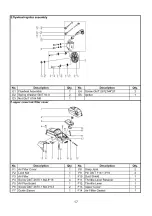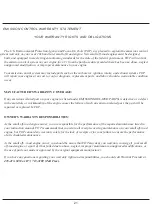
6
Important Operation Reminders
Allow the engine to reach full speed
before cutting.
Begin cutting with the saw frame
resting against the log.
Keep the engine at full speed the
entire time you are cutting.
Allow the chain to do the work for
you. Do not apply excess pressure.
Forcing the cut may cause damage
to the engine, bar and/or chain.
When the cut is complete, release
the trigger and allow the engine to
return to idle. Running the saw at full
throttle without cutting can cause
wear to the chainsaw.
Do not put pressure on the saw at
the end of a cut in order to maintain
control of the saw.
Stop the engine before setting down
the saw.
Tree Felling
WARNING
: Do not cut near buildings
or electrical wires if the direction of
the fall is uncertain. Check for broken
or dead branches, which could fall
while cutting. Do not cut at night or
during bad weather. If the tree falls
onto a utility line, notify the utility
company immediately.
Plan your sawing operation in
advance. Clear the work area in
order to have a secure footing.
Evaluate the natural conditions that
could affect the direction of the fall
such as wind, lean of the tree, weight
and branches on one side,
surrounding trees, decay and rot.
Make sure the tree has enough room
to fall. Keep a distance of at least 2
½ tree lengths from the nearest
person or object because engine
noises or the tree falling can drown
out warning calls.
Remove all foreign objects from the
tree where the cuts are going to be
made. Plan a clear retreat path that
is diagonally back from the line
of the fall.
Felling Large Trees (6 in. or larger
in diameter)
A notch is cut into the side of the
tree in the desired falling direction.
After a felling cut is made, the tree
will tend to fall into the notch.
Note:
If the tree has large buttress
roots, remove them before making
the notch into the tree. If you use a
chainsaw to remove the roots, keep
the chain from contacting the ground
to prevent the chain from dulling.
1) Make the notch by cutting the top
of the notch first. Cut through 1/3 of
the diameter of the tree. Complete
the notch by cutting the bottom of
the notch. Remove the notch of
wood from the tree once the notch is
cut.
2) After removing the wood, make
the felling cut on the opposite side of
the notch. Make a cut about two
inches higher than the center of the
notch. This will leave a hinge
between the felling cut and the
notch. The hinge will help prevent
the tree from falling in the wrong
direction. It also helps hold the tree
on the stump and control the fall.
Before the felling cut is complete,
use wedges, if necessary, to open
the cut and control the direction of
the fall. Use wood or plastic wedges
to avoid kickback and chain
damage. Never use steel or iron
wedges.
Be alert to signs that the tree is
about to fall, such as cracking
sounds, widening of the felling cut,
or movement in the branches.
As the tree begins to fall, stop and
put down the saw and quickly get
away on your planned retreat path.
Do not cut down a partially fallen
tree. Be cautious when working
around partially fallen trees
because they may be poorly
supported. If a tree does not fall
completely, put the saw aside and
pull down the tree with a cable
winch, block and tackle or a tractor.
Cutting A Fallen Tree (Bucking)
WARNING:
DO NOT stand on the
log that is being cut. If the log rolls,
it can cause loss of footing and
control. Do not stand downhill of
the log being cut.
Only cut one log at a time.
Cut shattered wood carefully.
Sharp pieces of wood could
possibly be thrown back towards
the operator.
Never allow another person to hold
a small log for cutting, or use your
leg or foot to hold it. Use a
sawhorse to cut small logs.
Do not cut in an area where logs,
roots and limbs are tangled. Drag
the logs into a clear area before
cutting.
Types of Cutting for Bucking
WARNING: If a saw becomes
pinched in a log, do not try to force
it out. It is possible to lose control
of the saw which can result in injury
and/or damage to yourself or the
saw. Stop the saw and drive a
plastic or wood wedge into the cut
until the saw can be removed.
Restart the saw and re-enter the
cut. Using a metal wedge can
cause kickback and chain damage.
Do not attempt to restart your saw
when it is pinched in a log.
Summary of Contents for 20120
Page 13: ...13 Parts List...
Page 14: ...14...
Page 15: ...15...
Page 16: ...16...
Page 17: ...17...
Page 18: ...18...
Page 19: ...19...







































